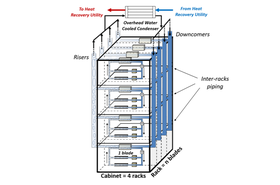Direct-to-chip liquid cooling has been around for decades, and immersion cooling since the mid-2000s or so. But now, with CPU’s running at ever-greater wattages and high-powered GPUs in such demand that chip makers can barely keep up, an inflection point has been reached, believes Josh Claman, CEO at two-phase, direct-to-chip liquid cooling specialist, Accelsius.
Moreover, with rack densities going in the same direction, air cooling is already struggling to deal with the generated heat, and that’s before taking into account the need to capture and reuse exhaust server heat in the name of sustainability and net-zero.
“Liquid cooling as a sort of a pragmatic solution has always been niche. But we’re seeing the dynamic rapidly changing. Mainstream CPUs are becoming much hotter after years of incremental increases in wattage so, suddenly, we’re seeing a J-curve in terms of the heat that these chips produce,” says Claman.
Accelsius is working on two-phase, direct-to-chip liquid cooling technology originally developed by Nokia’s Bell Labs, with a brief to commercialize it, starting this year.
However, one of the problems that data center operators are facing is the conundrum over which cooling technologies to adopt – and of the plethora of offerings, which companies' designs will be most suitable?
“These are big decisions for operators, which I don't want to make light of. The reticence really comes into some old thinking around, ‘Well, we've talked about this for years. So why the urgency now?’... That's a small minority of operators out there, but they exist.
“Others are saying, ‘Where do I absolutely need this cooling technology? I know we have some orders from clients that are coming in at maybe 70 kilowatts per rack, maybe even 100 kilowatts per rack. I know I need to move so I want to start evaluating some of these technologies before I commit to one across all of my data center properties’,” explains Claman.
“I can't argue with that. I think it's prudent thinking. So we do see some reticence, particularly with the colo players whose financials tend to follow a different path. But the hyper scalars are moving into liquid cooling, too, and we have some smaller AI players who are doing AI, cloud and so on that are also moving very, very quickly,” he adds.
In other words, there’s a wide variety of approaches to liquid cooling at the moment – but it’s now on everyone’s radar and a question of ‘when’ and ‘how’, not if.
And then there’s the financial side: will such investments all add up when placed under the magnifying glasses of the CEO and CFO?
“We want to make sure that we have a very compelling commercial proposition, as well as aligning to ESG initiatives and governance. But if you go back a layer and you say, ‘Okay, about three percent of the generated energy on Earth goes into data centers’ that number never really surprises anyone.
“What surprises people is about 1.2 percent of their US energy is focused on cooling data centers – not on processing data, but on cooling data centers. We think we can take that down by 80 percent and dramatically reduce carbon emissions. On the commercial side, we can also reduce operational expenditure (OPEX),” says Claman.
Moreover, incoming regulatory regimes in the EU will force caps on PUE on new data center developments, as well as demanding heat reuse, and only liquid cooling – two-phase, direct-to-chip liquid cooling in particular – can satisfy all these various different demands, believes Claman.
Click here to watch the full DCD>Talks discussion with Accelsius CEO Josh Claman
More...
-

Two-phase cooling startup Accelsius offers test-drive program
Kickstart lets operators try the NeuCool tech in their own facilities
-

Will liquid cooling really deliver hot water?
The new world of cooling may end up looking a lot like the old world
-

Nokia Bell Labs spins off liquid cooling tech, creates new company Accelsius
Novel cooling startup launched with help of Innventure


